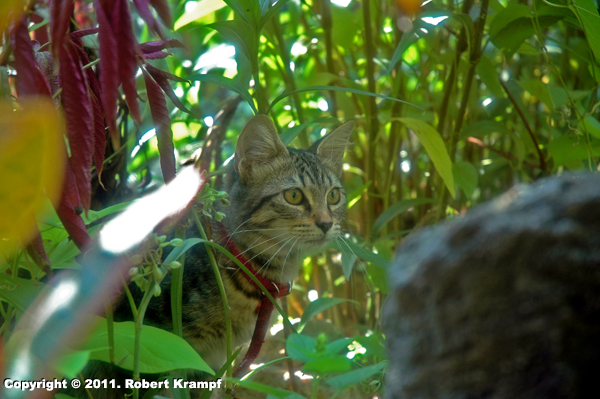
At some time in your life, you have probably heard that in a fall, cats always land on their feet. Is that true? Well, usually it is. Cats have the amazing ability to turn themselves right side up as they are falling. That does not mean that a fall will not injure them. If you fell off a tall building, would landing on your feet keep you from being injured? No. The same is true for cats. Landing on their feet lets their legs flex to absorb some of the impact, and keeps the impact from directly hitting more delicate bones, but cats do not have any magical protection against injury from falling.
Safety Warning
Do not try dropping your cat! This is dangerous for both the cat (which can break bones and injure muscles) and for you (cats have sharp claws.)
What is amazing is the way that they perform this trick of landing on their feet. They do it by combining fast reflexes with the laws of physics.
To get an idea of how they do it, you will need:
- a chair that swivels easily. Common office chairs work very well for this.
- an open area with plenty of room, so you don't break any lamps, furniture, or legs.
OK, lets start by thinking about what the cat has to accomplish. It is falling, which means that it does not have anything to push or pull on to turn itself. Instead of falling, you can get an idea of the problem that they face by sitting in the swivel chair. Make sure that you have plenty of open space around you by holding your feet straight out and turning in a complete circle. You want at least a foot or two of open space between your feet and the closest thing you could bump into.
Now lets get an idea of the challenge the cat faces. Sit cross legged in the chair, so your feet do not stick out. Put your arms in your lap, with your elbows tucked in against your side. Your challenge is to turn the chair around so that you are facing the opposite direction by twisting your body from side to side. Don't move your arms or legs. You can twist at the waist and your neck, but nothing else. DON'T HURT YOURSELF! You will find that you can turn the chair slightly to the right by twisting your body to the left. The problem is that when you twist back to the right, the chair spins back to the left, winding up back where it started. Wiggling the chair back and forth is no problem, but you don't get very far towards turning the chair around.
To see how the cat manages its trick, lets try something different. Keep your elbows at your side, but extend your hands out to the side. Then try twisting again. This time you will notice that the same motions cause you to swivel back and forth farther. Extend your arms all the way out, and try it again. Now, you are really moving back and forth. As you move your arms further and farther from your body, you can use their inertia (resistance to changes in motion) to push against.
You still have the problem that you are twisting back and forth. Remember that you are a falling cat, and you need to turn yourself so you can land on your feet. That leads us to your next step.
Extend your arms all the way out, and then twist to your left. That swivels the chair and your body to the right. Now, before you twist the other direction, pull your arms back in close to your body. Since your arms are in close, you can turn back without swiveling the chair back in the other direction. You have turned part of the way around, and you are back into the position to do it again. Extend your arms again, and repeat the process. It took me three arm swings to turn my chair around so that I was facing in the opposite direction.
Cats do this maneuver even better because they are incredibly flexible. They extend their front legs while pulling in their back legs, and then twist in the direction they want to turn. Very quickly, they pull in their front legs, and extend their back legs, making another quick twist that lets them wind up facing as much as 180° from their original direction.
Although cats are incredibly fast at this, it still takes time. Cats that fall from a very short distance do not have enough time to twist around. Also remember that landing on their feet does not mean that they don't get hurt during a fall. Their reflexes and flexibility can help them land in the best position, but they can still suffer injuries and broken bones from a fall; so you should not use your cat as an experimental subject.
If you want to experiment further, try holding a weight in each hand as you do the experiment. Do you think that will make it work better or worse? Try experimenting with different arm motions. I had interesting results from making the same motions that you would use for paddling a canoe.
